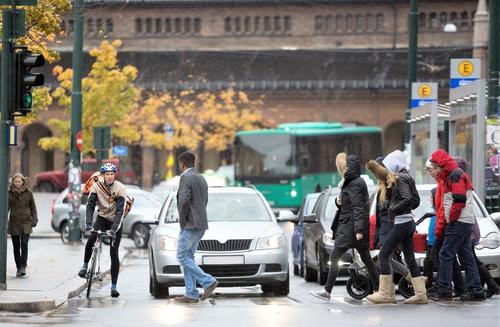Translated by Petter Gundersen, TØI
Interaction problems in traffic and the risk of serious accidents must be taken seriously. A new survey points to challenges pedestrians, cyclists and motorists experience in interaction with each other.
The survey shows that many people feel safe in traffic, but when studying the challenges the different actors face, the cyclists often feel insecure and frustrated in encounters with trucks and buses, while motorists and pedestrians feel insecure in encounters with cyclists and e-scooters.
Recurring problems are uncomfortably close crossings, non-compliance with the duty to yield, inadequate use of reflectors and lights, inadequate knowledge of cyclists' duty to yield, and the rules that apply to cycling and the use of e-scooters on sidewalks and walkways.
Main findings:
- For motorists, cyclists who cycle in the car lanes, insufficient use of light and reflectors, and unpredictable behaviour among pedestrians and cyclists are sources of insecurity and frustration.
- Cyclists experience motorists why do not comply with the duty to yield and find it frightening when cars, buses and lorries pass them too close.
- Pedestrians (and motorists) often feel insecure and frustrated in their interactions with cyclists and e-scooters.
- Cyclists who cycle for exercise purposes experience more negative gestures and unpleasant situations than other cyclists.
- Women experience interactions in traffic as less safe and smooth than men.
- Older respondents feel more frustrated and less secure than younger respondents when meeting e-scooters and cyclists.
- Respondents from Oslo / Akershus experience more frustration and insecurity with both cyclists and e-scooters than people in other urban areas.
If new information measures and attitude campaigns are to be established, the researchers at TØI recommend that these be directed at two specific areas:
- Problems related to blind zone and collisions that occur when motor vehicles make a right turn and come into conflict with cyclists, e-scooters or pedestrians who is going straight ahead. Most serious accidents involving pedestrians and cyclists occur in situations like these, especially when interacting with heavy vehicles.
- Failure to use turn signals and other forms of signalling leads to frustration and unpredictability and can create misunderstandings and serious accidents. With a steady increase in the number of cyclists and e-scooters, signalling is becoming more important for traffic safety both in interactions between these and motorists, and between pedestrians and cyclists on pedestrian and cycle paths.
Campaigns are more effective when you focus the message close to where the problem exists and by combining information measures with specific guidance and training - and when the police is backing up these measures.
The survey was conducted with the help of Kantar AS. The regions included in the survey were: Oslo / Akershus, Bergen, Trondheim, Nord-Jæren, Kristiansand region, Buskerudbyen, Grenland, Nedre Glomma and Tromsø.
The client is the Norwegian Public Roads Administration and the report will be used as a basis for a new “Share the Road” campaign.






